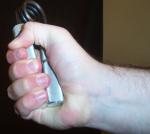No products in the cart.
Hand Size
Hand size is the length of the hand as measured from the crease in the wrist closest to the palm to the tip of the longest finger. An average sized hand for a male is 7.5″. Less than 7″ would be a small hand, greater than 8″ a large hand. Hand size should be taken into consideration when selecting training tools and exercises. The preferred width for pinch work, bar diameter for thick bar work, and set width for gripper work are all impacted.
Crushing Strength
Crushing strength is the ability of the hand to generate force when moving from an open to closed position. Closing a hand gripper or smashing an apple draws upon crushing strength. The primary movers are the flexors of the fingers and thumb. The wrist acts as base of support. This means to develop a high level of crushing strength it is necessary to do direct work for the thumb and wrist, in addition to the fingers.

Pronation of the Hand
Palm down. Holding the arm straight in front of the body, turn it so the palm faces down. The primary mover in this movement is the triceps.

Supination of the hand
Holding the arm straight in front of the body, turn it so the palm faces up. The primary mover in this movement is the biceps

Radical deviation
Bend the wrist to move the thumb towards the forearm with minimal wrist flexion or extension

Ulnar deviation
Bend the wrist to move the pinky towards the forearm with minimal wrist flexion or extension.

Wrist extension
Bend the wrist to move the back of the hand towards the forearm.

Wrist flexion
Bend the wrist to move the palm of the hand towards the forearm

Wrist neutral
In the neutral position, the wrist has no flexion or extension. The first two knuckles of the fisted hand are straight in line with the forearm.

